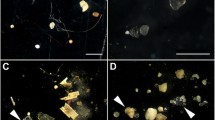Abstract
Total Hg contents from abiotic (surface sediments and suspendedparticulate matter) and biological (crabs, fishes and halophytes)compartments from Bahía Blanca estuary and Mar Chiquita CoastalLagoon, Argentina, have been monitored since the 1980's. At BahíaBlanca estuary, high Hg concentrations were recorded during the early1980's in surface sediments (0.34 ± 0.22 μg/g) andsuspended particulate matter (0.19 ± 0.10 μg/g). Fishspecies, Mustelus schmitti (0.89 ± 0.29 μg/g), Paralichthys brasiliensis (0.85 ± 0.18 μg/g) and Micropogonias furnieri (0.37 ± 0.11 μg/g) also presentedhigh Hg concentrations. The large industrial nucleus located within theestuary has been identified as the main metal source for this environment.Hg contents from the same area during 1996–1998 were significantlylower: surface sediments (0.164 ± 0.023 μg/g), suspendedparticulate matter (0.048 ± 0.0017 μg/g), fish Micropogonias furnieri (0.13 ± 0.02 μg/g) and crab Chasmagnathus granulata (0.334 ± 0.071 μg/g). This trendof environmental detoxification is probably related with (i) thetechnological changes incorporated by the local industry, (ii) a mostadequate management of industrial effluents, and (iii) the removal ofgreat sediment volume by dredging and refill.During the 1980's Mar Chiquita Lagoon Hg concentrations reached 0.08± 0.01 μg/g in surface sediments and 0.09 ±0.025 μg/g in suspended particulate matter, and 0.14 ±0.04 μg/g in the fish Basilichthys bonariensis and 0.22 ±0.08 μg/g in Paralichthys brasiliensis, and 0.08 ±0.01 μg/g in the crab C. granulata, Hg concentrations werelower than at Bahía Blanca. Remote Hg sources for this Coastal Lagoonand atmospheric and stream transport of Hg is proposed as major Hgsources, since no Hg point sources exists nearby. Mercury concentrationsrecorded in the 1996–1998 period were lower than those recorded inthe previous decade: surface sediments (0.019 ± 0.004 μg/g), suspended particulate matter (0.030 ± 0.008 μg/g), halophyte Spartina densiflora (0.013 ± 0.008 μg/g) or crab C. granulata (0.011 ± 0.009 μg/g).Both Hg bioaccumulation and biomagnification processes were verified inBahía Blanca estuary and in Mar Chiquita Coastal Lagoon. This apparentrecovery of both estuarine environments deserves to be carefully analyzed,in order to fully understand the foundations of these processes.
Similar content being viewed by others
References
American Public Health Association (Apha). American Water Works Association (Awwa). Water Pollution Control Federation (Wpcf). 1992. Standard methods for the examination of water and wastewater. APHA, Washington DC, 14th Ed., 1193 pp.
Barcellos, C., Lacerda, L.D. and Ceradini, S. 1997. Sediment origin and budget in Sepetiba Bay (Brazil)–an approach based on multi-elemental analysis. Environ. Geol. 32: 203-209
Clarkson, T.W. 1992. Mercury: major issues in environmental health. Env. Health Pers. 100: 31-38
Fasano, J.L., Hernández, M.A., Isla, F.I. and Schnack, E.J. 1982. Aspectos evolutivos y ambientales de la laguna Mar Chiquita (provincia de Buenos Aires, Argentina). Ocean. Acta SP: 285-292.
Freije, R.H., Asteasuain, R.O., Schmidt, A.S. De and Zavatti, J.R. 1981. Relación de la salinidad y la temperatura del agua con las condiciones meteorológicas en la porción interna del estuario de Bahía Blanca, Argentina. Contribución Científica IADO 57: 20 pp.
Horvat, M., Covelli, S., Faganelli, J., Logar, M., Maudic, V., Rajar, R., Sirca, A. and Zagar, D. 1999 Mercury in contaminated coastal environments; a case study: the Gulf of Trieste. Sci. Total Env. 237/238: 43-56.
Lacerda, L.D., Freixo, J.L. and Cardoso, S.M. 1997. The effect of Spartina alterniflora Loisel. on the accumulation of Cd and Zn in inter-tidal sediments. Mang. Salt Marsh. 1: 201-209.
Lanfredi, N.W., Balestrini, C.F., Mazio, C.A. and Schmidt, S.A. 1981. Tidal sandbanks in Mar Chiquita Coastal Lagoon, Argentina. J. Coastal Res. 3: 515-520.
Law, R.J., Jones, R.B., Baker, J.R., Kennedy, S., Milne, R. and Morris, R.J. 1992. Trace metals in the liver of marine mammals from the Welsh Coast and the Irish Sea. Marine Poll. Bull. 24: 296-304.
Legret, M. and Pagotto, C. 1999 Evaluation of pollutant loading in the runoff waters from a major rural highway. Sci. Total Env. 235: 143-150.
Marcovecchio, J.E. 1988. Estudio comparativo de la distribución de los metales traza mercurio, cadmio y zinc en organismos de dos zonas estuariales de Argentina: Bahía Blanca y desembocadura del Río de la Plata. Doctoral Thesis, Universidad Nacional de Mar del Plata (Argentina), 212 pp.
Marcovecchio, J.E., Lara, R.J. and Gomez, E. 1986a. Total mercury in marine sediments near a sewage outfall. Relation with organic matter. Env. Technol. Lett. 7: 501-507
Marcovecchio, J.E., Obenat, S.M., Pérez, A. and Moreno, V.J. 1986. Total mercury and lead contents in the biota at Mar Chiquita coastal lagoon, Province of Buenos Aires, Argentine Republic. J. Shoreline Manag. 2: 207-222.
Marcovecchio, J.E., Moreno, V.J. and Perez, A. 1988.a. Total mercury contents in marine organisms of the Bahía Blanca estuary trophic web. In: Seeliger, U., de Lacerda, L.D. and Patchineelam, S.R. (eds.), Metals in Coastal Environments of Latin America, pp. 122-129. Springer-Verlag, Heidelberg.
Marins, R.V., Lacerda, L.D., Goncalves, G.O. and Paiva, E.C. 1997. Effect of root metabolism on the post-depositional mobilization of mercury in salt marsh soils. Bull. Env. Cont. Toxicol. 58: 733-738.
Olivier, S.R., Escofet, A., Penchaszadeh, P. and Orensanz, J.M. 1972. Estudios ecológicos de la región estuarial de Mar Chiquita (Buenos Aires, Argentina). Las comunidades bentónicas. Anales de la Sociedad Científica Argentina. 93: 237-262.
Villa, N. and Pucci, A.E. 1987. Seasonal and spatial distributions of copper, cadmium and zinc in the seawater of Blanca Bay. Est. Coast. Shelf Sci. 25: 67-80.
Author information
Authors and Affiliations
Rights and permissions
About this article
Cite this article
Marcovecchio, J.E., Andrade, S., Ferrer, L.D. et al. Mercury distribution in estuarine environments from Argentina: the detoxification and recovery of salt marshes after 15 years. Wetlands Ecology and Management 9, 317–322 (2001). https://doi.org/10.1023/A:1011860618461
Issue Date:
DOI: https://doi.org/10.1023/A:1011860618461




